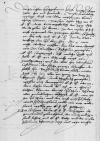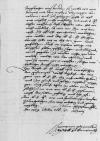Uns sein dÿsen thag von E(wer) F(urstlichen) D(urchlauch)t dreÿ brive, ungeferlich den XXVI dÿts monts geben, zu komen, / in dem cf. Albrecht I von Hohenzollern-Ansbach to Ioannes DANTISCUS Königsberg, 1538-10-26, CIDTC IDL 4940⌊erstencf. Albrecht I von Hohenzollern-Ansbach to Ioannes DANTISCUS Königsberg, 1538-10-26, CIDTC IDL 4940⌋ E(wer) F(urstliche) D(urchlauch)t unss erÿnnert der grentzen halben, / so zwischen Ermland (Warmia, Varmia), diocese and ecclesiastical principality in northeastern Poland, 1466-1772 within the Kingdom of Poland, Royal Prussia⌊dis ortsErmland (Warmia, Varmia), diocese and ecclesiastical principality in northeastern Poland, 1466-1772 within the Kingdom of Poland, Royal Prussia⌋ und E(wer) F(urstlichen) D(urchlauch)t Prussia, region in central Europe, bordered by Pomerania, Poland, Lithuania and Livonia. From 1466 Prussia was divided into Royal Prussia (Prussia Regalis), which was a part of the Kingdom of Poland, and Teutonic Prussia (Prussia Ordinis Theutonici) – covering the remnants of the former territory of the Teutonic Order’s state in Prussia. In 1525, the Order’s last Grand Master, Albrecht von Hohenzollern, converted to Lutheranism and became the first lay duke in former Teutonic Prussia (dux in Prussia), which from then on was called Ducal Prussia (Prussia Ducalis). At that time, as a result of the treaty of Cracow, Ducal Prussia became a fief of the kings of Poland⌊landenPrussia, region in central Europe, bordered by Pomerania, Poland, Lithuania and Livonia. From 1466 Prussia was divided into Royal Prussia (Prussia Regalis), which was a part of the Kingdom of Poland, and Teutonic Prussia (Prussia Ordinis Theutonici) – covering the remnants of the former territory of the Teutonic Order’s state in Prussia. In 1525, the Order’s last Grand Master, Albrecht von Hohenzollern, converted to Lutheranism and became the first lay duke in former Teutonic Prussia (dux in Prussia), which from then on was called Ducal Prussia (Prussia Ducalis). At that time, as a result of the treaty of Cracow, Ducal Prussia became a fief of the kings of Poland⌋ nottorfftig sein zu betzÿhen, / doruff wir nicht anders wÿssen, / dan das wir, / dyweÿl wir im Kulm diocese (Chełmno diocese)⌊colmischen bÿschtumKulm diocese (Chełmno diocese)⌋ gewesen, / E(wer) D(urchlauch)t angetzeÿgt, / uff welche zeÿtt und stelle E(wer) D(urchlauch)t yre council of Ducal Prussia ⌊rethecouncil of Ducal Prussia ⌋ nicht weÿt von(n) Lewthenberg⌊LawthenbergLewthenberg⌋ / und der edel her Mikołaj Działyński (Nikolaus von Dzialin) (†1545), from 1507 royal courtier; 1510-1528 Chamberlain of Dobrzyń; 1528-1544 Castellan of Kulm (Chełmno); 1544-1545 Voivode of Pomerania; Starosta of Bratian, Strasburg in Preussen (Brodnica), and Dobrzyń (PSB 6, p. 92-94; Urzędnicy 5/2, p. 204)⌊colmischer(r) castellannMikołaj Działyński (Nikolaus von Dzialin) (†1545), from 1507 royal courtier; 1510-1528 Chamberlain of Dobrzyń; 1528-1544 Castellan of Kulm (Chełmno); 1544-1545 Voivode of Pomerania; Starosta of Bratian, Strasburg in Preussen (Brodnica), and Dobrzyń (PSB 6, p. 92-94; Urzędnicy 5/2, p. 204)⌋, / den solche grentze betreffen, / doselbst hin perssonlich komen soldt. / Mitler zeÿt seÿ wir uber ein gantz jar lang in keÿnner Provincial Diet of Royal Prussia ⌊dÿser lande thagfarthProvincial Diet of Royal Prussia ⌋ gewesen(n), / wÿssen auch derwegenn(n) E(wer) F(urstlichen) D(urchlauch)t ader andern dÿser lande Sigismund I Jagiellon (Zygmunt I) (*1467 – †1548), King of Poland and Grand Duke of Lithuania (1506-1548); Duke of Głogów (Glogau) (1499-1506), Duke of Opava (1501-1506), Governor of Silesia (1504-1506); son of King Kazimierz IV Jagiellon and Elisabeth of Austria⌊ko(nigliche)r m(aieste)tSigismund I Jagiellon (Zygmunt I) (*1467 – †1548), King of Poland and Grand Duke of Lithuania (1506-1548); Duke of Głogów (Glogau) (1499-1506), Duke of Opava (1501-1506), Governor of Silesia (1504-1506); son of King Kazimierz IV Jagiellon and Elisabeth of Austria⌋, u(nsers) a(llergnedigsten) hern(n), Council of Royal Prussia the most important local authority in Royal Prussia. It consisted of two bishops (of Ermland (Warmia), who served as the Council’s president, and of Kulm (Chełmno)), three voivodes (of Kulm, Marienburg (Malbork), and Pomerania), three castellans (of Kulm, Elbing (Elbląg), and Gdańsk (Danzig)), three chamberlains (of Kulm, Marienburg, and Pomerania), and representatives of the three Great Prussian Cities – Gdańsk, Thorn (Toruń), and Elbing (ACHREMCZYK 2016, p. 17-18)⌊rethenCouncil of Royal Prussia the most important local authority in Royal Prussia. It consisted of two bishops (of Ermland (Warmia), who served as the Council’s president, and of Kulm (Chełmno)), three voivodes (of Kulm, Marienburg (Malbork), and Pomerania), three castellans (of Kulm, Elbing (Elbląg), and Gdańsk (Danzig)), three chamberlains (of Kulm, Marienburg, and Pomerania), and representatives of the three Great Prussian Cities – Gdańsk, Thorn (Toruń), and Elbing (ACHREMCZYK 2016, p. 17-18)⌋ / keynnen bericht zu thun. / So uns aber gruntlichern bescheÿdt E(wer) D(urchlauch)t, / was hir ÿn zu thun, / und das unss auch zu steth, / wirdt zuschreÿbenn(n), / wolle wir uns unbeswert wÿllig gen E(wer) F(urstliche) D(urchlauch)t halthen etc.
Im andren cf. Albrecht I von Hohenzollern-Ansbach to Ioannes DANTISCUS Königsberg, 1538-10-25, CIDTC IDL 4938⌊brivecf. Albrecht I von Hohenzollern-Ansbach to Ioannes DANTISCUS Königsberg, 1538-10-25, CIDTC IDL 4938⌋[1] E(wer) F(urstliche) D(urchlauch)t antzeygen dÿ gemeÿnnen(n) gebrechenn(n) / der muntz und gesind lohns und E(wer) D(urchlauch)t council of Ducal Prussia ⌊rethecouncil of Ducal Prussia ⌋ und Council of Royal Prussia the most important local authority in Royal Prussia. It consisted of two bishops (of Ermland (Warmia), who served as the Council’s president, and of Kulm (Chełmno)), three voivodes (of Kulm, Marienburg (Malbork), and Pomerania), three castellans (of Kulm, Elbing (Elbląg), and Gdańsk (Danzig)), three chamberlains (of Kulm, Marienburg, and Pomerania), and representatives of the three Great Prussian Cities – Gdańsk, Thorn (Toruń), and Elbing (ACHREMCZYK 2016, p. 17-18)⌊der unserCouncil of Royal Prussia the most important local authority in Royal Prussia. It consisted of two bishops (of Ermland (Warmia), who served as the Council’s president, and of Kulm (Chełmno)), three voivodes (of Kulm, Marienburg (Malbork), and Pomerania), three castellans (of Kulm, Elbing (Elbląg), and Gdańsk (Danzig)), three chamberlains (of Kulm, Marienburg, and Pomerania), and representatives of the three Great Prussian Cities – Gdańsk, Thorn (Toruń), and Elbing (ACHREMCZYK 2016, p. 17-18)⌋ zusamne khomen etc. Wÿ wol wÿr nichts  GStA, PK, HBA, C 1, No 533, f. 2 unnumbered dergleychen vorstanden, / so wolle wir uns dennoch mit den unsern derwegen beredenn / und zu gelegner zeÿtt, so vÿl uns muglich, nicht misfellig antwurt E(wer) D(urchlauch)t lassen wÿssen etc. Dass schÿssen aber hab wir auch muntlich, / do wir von den unsern negst dÿ pflicht eynnhomen(n), / vorbothen. / Wir wolten wol, das E(wer) F(urstliche) D(urchlauch)t rechten bericht hette, wÿ es beÿ den ÿren wirt gehalthen, / dass dÿ unsern etliche mit buchssen(n) solten geshen seÿn, / und solch antwurt gegeben, / sy wusten nichts von dem vorboth, / wolthe wir der nhamen(n) / und wer sy weren gerne wÿssen, / solthen irer byllicher straff nicht entghen[2] etc.
GStA, PK, HBA, C 1, No 533, f. 2 unnumbered dergleychen vorstanden, / so wolle wir uns dennoch mit den unsern derwegen beredenn / und zu gelegner zeÿtt, so vÿl uns muglich, nicht misfellig antwurt E(wer) D(urchlauch)t lassen wÿssen etc. Dass schÿssen aber hab wir auch muntlich, / do wir von den unsern negst dÿ pflicht eynnhomen(n), / vorbothen. / Wir wolten wol, das E(wer) F(urstliche) D(urchlauch)t rechten bericht hette, wÿ es beÿ den ÿren wirt gehalthen, / dass dÿ unsern etliche mit buchssen(n) solten geshen seÿn, / und solch antwurt gegeben, / sy wusten nichts von dem vorboth, / wolthe wir der nhamen(n) / und wer sy weren gerne wÿssen, / solthen irer byllicher straff nicht entghen[2] etc.
Der drÿtt E(wer) D(urchlauch)t cf. Albrecht I von Hohenzollern-Ansbach to Ioannes DANTISCUS Königsberg, 1538-10-25, CIDTC IDL 4939⌊brÿffcf. Albrecht I von Hohenzollern-Ansbach to Ioannes DANTISCUS Königsberg, 1538-10-25, CIDTC IDL 4939⌋ thut uns befelhen den gestrengen Wolf Nathaft (Wolf Nothaft) (†1553), servant of Duke Albrecht von Hohenzollern and King of Sweden Gustav I Vasa (HARTMANN 1525-1550, No. 530, 533)⌊Wolff NhatastWolf Nathaft (Wolf Nothaft) (†1553), servant of Duke Albrecht von Hohenzollern and King of Sweden Gustav I Vasa (HARTMANN 1525-1550, No. 530, 533)⌋, / den wir gern von E(wer) F(urstlichen) D(urchlauch)t beÿ unss wollen haben(n) / und im gunst und guthen wÿllen ertzeÿgen, / auch sunst thun in allen andren sachenn(n) an uns von E(wer) F(urstlichen) D(urchlauch)t gesonnen(n), / wass der selbten gefellig und lyb yst, / dan E(wer) F(urstliche) D(urchlauch)t uns mit freuntlichen dynsten zuvorhalthen / sein wir erbottig und gantz wÿllig. /
 GStA, PK, HBA, C 1, No 533, f. 3 unnumbered
GStA, PK, HBA, C 1, No 533, f. 3 unnumbered  GStA, PK, HBA, C 1, No 533, f. 1 unnumbered
GStA, PK, HBA, C 1, No 533, f. 1 unnumbered  GStA, PK, HBA, C 1, No 533, f. 2 unnumbered dergleychen vorstanden, / so wolle wir uns dennoch mit den unsern derwegen beredenn / und zu gelegner zeÿtt, so vÿl uns muglich, nicht misfellig antwurt E(wer) D(urchlauch)t lassen wÿssen etc. Dass schÿssen aber hab wir auch muntlich, / do wir von den unsern negst dÿ pflicht eynnhomen(n), / vorbothen. / Wir wolten wol, das E(wer) F(urstliche) D(urchlauch)t rechten bericht hette, wÿ es beÿ den ÿren wirt gehalthen, / dass dÿ unsern etliche mit buchssen(n) solten geshen seÿn, / und solch antwurt gegeben, / sy wusten nichts von dem vorboth, / wolthe wir der nhamen(n) / und wer sy weren gerne wÿssen, / solthen irer byllicher straff nicht entghen[2] etc.
GStA, PK, HBA, C 1, No 533, f. 2 unnumbered dergleychen vorstanden, / so wolle wir uns dennoch mit den unsern derwegen beredenn / und zu gelegner zeÿtt, so vÿl uns muglich, nicht misfellig antwurt E(wer) D(urchlauch)t lassen wÿssen etc. Dass schÿssen aber hab wir auch muntlich, / do wir von den unsern negst dÿ pflicht eynnhomen(n), / vorbothen. / Wir wolten wol, das E(wer) F(urstliche) D(urchlauch)t rechten bericht hette, wÿ es beÿ den ÿren wirt gehalthen, / dass dÿ unsern etliche mit buchssen(n) solten geshen seÿn, / und solch antwurt gegeben, / sy wusten nichts von dem vorboth, / wolthe wir der nhamen(n) / und wer sy weren gerne wÿssen, / solthen irer byllicher straff nicht entghen[2] etc.


